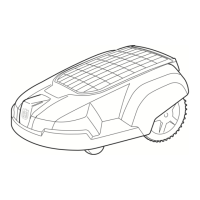12 Automower from
1. Function
™
.
1.8 Loop signal strength
1.8.1 Boundary wire
The signal strength on the boundary wire is constant at
a loop length of up to about 500
metres. However,
when the loop is longer than 500
metres, the strength
can start to depreciate even if it may still be adequate.
The strength of the loop signal varies depending on the
distance to the wire. Directly by the wire the signal
strength is high. The strength then depreciates the
further you come from the wire. Outside of the loop the
signal is negative and its strength depreciates quicker.
The signal from the boundary wire is called the
A-signal. See the picture below for examples of high
and low signal strengths.
Table 3: Faulty control signals
Fault Cause
A-signal: The LED flashes every other
second = no signal.
The boundary wire is broken or the circuit card in the
charging station is defective. See page
104 to replace the
card.
A-signal: The LED flashes twice every
other second = signal detected but the
signal is too weak.
Too high loop resistance. This is probably due to damage
on some part of the loop, e.g. a splice.
No F-signal. Defective coil in the charging station plate or a defective
circuit card. See page
104 to replace the plate. See
page 104 to replace the card.
No N-signal. Defective coils in the charging station plate or a defective
circuit card. See page
104 to replace the plate. See
page 104 to replace the card.
3012-612
Examples of high and low signal strengths
300
275
250
Narrow head =
low strength
In-turned corner =
low strength
Out-turned corner =
high strength

